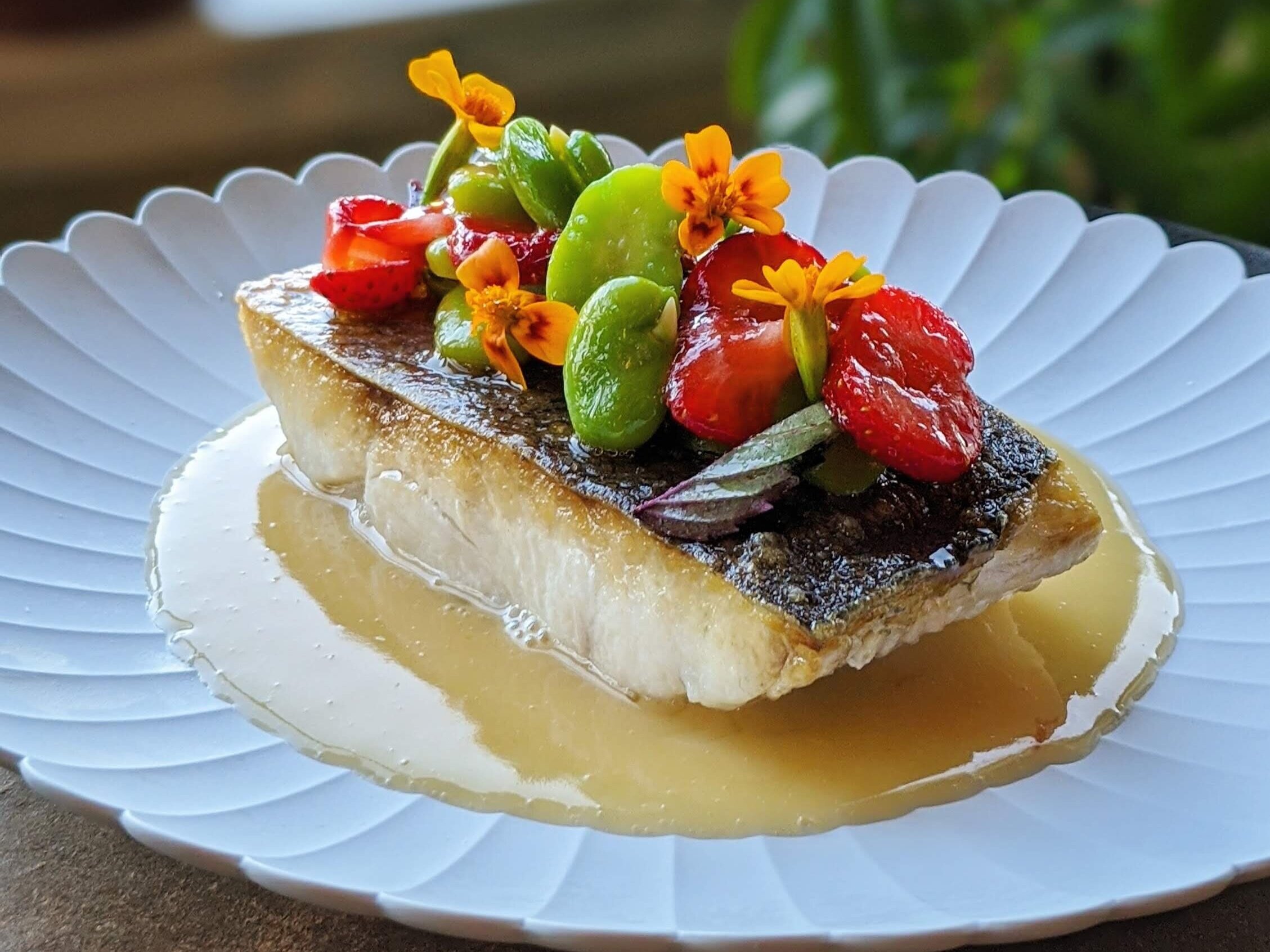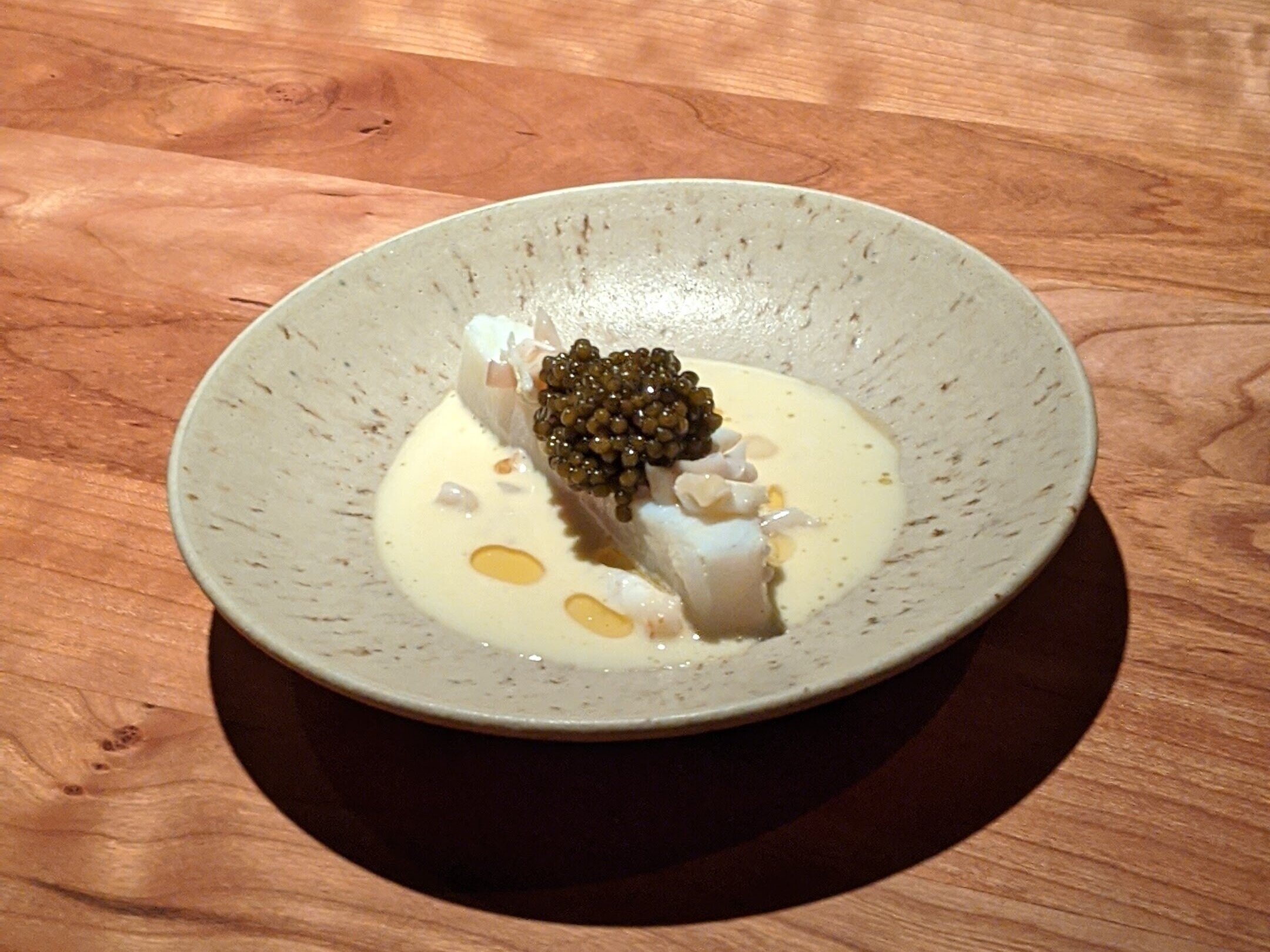Modern Beurre Blanc Recipe
Beurre blanc sauces are taking over. The gourmet food scene is obsessed, and no flakey fish can escape their buttery bath.
But if you’re paying close attention, the world’s best restaurants aren’t making traditional beurre blanc sauces. They’re exploring a whole new universe of beurre blanc, and the internet hasn’t caught up.
I’m here to help.
THEORY
〰️
GOODS
〰️
PROCESS
〰️
THEORY 〰️ GOODS 〰️ PROCESS 〰️
THE THEORY
It took three years to write this article. Tasting every fine dining beurre blanc I could get my spoon in, testing every relevant cookbook – heck, I even worked at the restaurant that made my favorite beurre blanc! In this post, I’ll break down modern beurre blanc recipes into their component parts so you can create your own unique beurre blanc recipes.
What’s beurre blanc?
Beurre blanc is a weak emulsion of reduced white wine and vinegar with butter. All the flavor of butter with none of the heavy mouthfeel, it’s perfect for fish. The recipe is usually straight-forward:
Add chopped shallots, white wine, and vinegar to a sauce pan.
Reduce until there’s almost no liquid left, then strain the liquid.
On no or low heat, gradually add cold butter to the liquid, constantly whisking until the butter and liquid become a beautiful, acidic emulsion.
If that’s all you’re looking for, you can stop reading here. Try this recipe. I, on the other hand, wanted more.
THE BEURRE BLANC FRAMEWORK
Modern beurre blancs are decidedly more intense in flavor and presentation. But why?
To understand what makes modern beurre blancs special, I built a framework to identify what old and new beurre blancs have in common.
All beurre blancs consist of the following components:
Base liquid: Nearly any tasty liquid other than water will do. Why not water? Well, because then this sauce is called a beurre monte.
Acid: Usually in the liquid, but not always.
Butter: Preferably unsalted so that you can control the salt levels once you’ve dialed down the sauce’s consistency.
Sea bass with cultured butter and attika vinegar beurre blanc
Beurre blancs also require a mastery of the following:
Emulsification: This is what creates the awesome beurre blanc mouthfeel. Beurre blancs are notoriously weak emulsions because they are only stabilized by the butter solids. We’ll review methods to improve the stability.
Temperature control: A standard beurre blancs break at around 120f. That’s why you’ll see a lot of recipes tell you to whisk the butter off the heat. We’ll review methods that enable you to keep it at a higher temperature (or at least maintain a high temp after you make it).
Viscosity: You need to maintain the right butter/liquid ratio so that this feels like a luxurious, just-thick-enough sauce.
Now let’s break the rules.
Sablefish with beurre blanc of fermented cauliflower and tarragon powder.
THEORY
〰️
GOODS
〰️
PROCESS
〰️
THEORY 〰️ GOODS 〰️ PROCESS 〰️
THE GOODS
Here I identify ways to deviate from the traditional beurre blanc recipe to create a modern beurre blanc.
THE INGREDIENTS
#1: base liquid
The first step in nearly every beurre blanc recipe is to create a base liquid. In the traditional beurre blanc recipe, this is where you combine white wine, vinegar, and shallots to create a shallot-infused acid. But my research found that this liquid can be many things other than white wine and vinegar. Consider starting with:
Broth: Frantzen in Stockholm kicks off their beurre blanc with roasted turbot bones and razor clams. I love to use a clam stock. Others will go for a chicken stock.
Fermented liquids: 108 in Copenhagen used to make a beurre blanc of sorts using the liquid from fermented mushrooms. I’ve tried doing it with button mushrooms, and it rocks. I’ve also tried fermented white asparagus, fermented cauliflower, and more.
Whey: Another fermented liquid of sorts, I’ve also seen restaurants use whey (especially buttermilk whey). Try heating up a cultured buttermilk until it curdles (you can add a squeeze of lemon to speed up the process). Strain, and you’ll find yourself an awesome acidic liquid to use for your beurre blancs. Whey also stabilizes the sauce a bit (e.g. I can bring a buttermilk whey-based beurre blanc to around 140f).
Nut milk: Alouette in Copenhagen makes their own sunflower seed milk then reduces that for their beurre blanc. I’ve tried this with pistachios and walnuts, too.
Cream: Considered cheating by some, many add a dash of cream to their beurre blanc. This improves the color and stabilizes the sauce. Coconut cream works too.
Other alcohols: You can try sake, too. You can’t use red wine though (or else this would become a beurre rouge!).
Try flavoring the base liquid with herbs or spices. Tarragon is common. I made one with lemongrass, star anise, and a dash of coconut cream and was blown away.
#2: ACID
Acid is essential for brightening the base liquid and butter, and traditional beurre blancs use white wine vinegar. While the acid can be added at any point in the cooking process, I typically recommend adding the acid after emulsifying the butter. This makes it easier to correct for taste.
Many of the base liquids (e.g. white wine, whey, fermented liquids) are already acidic, but they’re usually not acidic enough. Here are some ways to add acidity:
Vinegar: So many options here, but to ensure my acid does not dilute the finished sauce, I prefer to use ättika vinegar in my beurre blanc.
Citrus juice: I’ve seen lemon, lime, yuzu, sudachi, buddha hand.
Yuzu kosho: This not only adds acidity and spice but it also helps to stabilize the emulsification.
Citrusy herbs: You can include chopped or dehydrated/powdered herbs such as lemon verbena, lemongrass, or lemon thyme.
Flavored oils: You can use an acidic oil (e.g. lemon skin oil, seabuckthorn oil) to split the beurre blanc after emulsifying. I explain this more further on.
Cultured butter: You can also just use cultured butter or goat’s milk butter (which is more acidic than cow’s milk butter) in the butter step.
PRO TIP
〰️
PRO TIP 〰️
Ättika vinegar. A trick I learned from the Frantzen cookbook, this is 3x as strong as regular vinegar. That enables you to add acid without imparting too much of a vinegar flavor.
#3: Butter
Butter ends up being the majority of this recipe, so don’t skimp on it! Use the best unsalted butter you can find. I recommend Kerrygold in a pinch, but finding something local will make this truly unique.
THE TOOLS
These are the tools I use to make my modern beurre blanc.
THEORY
〰️
GOODS
〰️
PROCESS
〰️
THEORY 〰️ GOODS 〰️ PROCESS 〰️
THE PROCESS
Creating the emulsioN
Once you’ve got all the ingredients chosen and ready to go, you’ve gotta create the infamous emulsion. Here’s what you should do:
Add your liquid of choice to a sauce pan.
Reduce your liquid if needed. Some liquids will be more intense than others. A fermented liquid might be flavorful enough as is, but a simpler one (like the traditional shallot recipe) needs reduction to be flavorful. I recommend weighing your reduced liquid when you’re first learning; you should aim to have at least 50g of flavorful liquid per guest.
Turn down your heat to as low as it will go, then add a knob of cold butter. Whisk the butter around in the pot. The cold butter will reduce the temperature of the liquid such that emulsification will be possible.
Continue to add and whisk in cubes of butter, waiting until the previous cubes are almost emulsified before adding more. The more butter you’ve added, the more butter you can add at once.
Be careful of the temperature! If your heat is still on, the emulsification will start increasing in temperature as emulsified butter represents a larger share of the pot relative to cold butter. You want the heat to be high enough to melt the new cold butter but not past 120f.
Continue adding butter until the consistency is where you want it to be. It should coat a spoon. Depending on the starting liquid, the amount of butter could be anywhere from 1.5x to 5x the weight of the liquid from the end of step 2.
FLAVORING the emulsion
Once the consistency is where you want it (or a little more thick than where you want it if you are adding a diluted acid), its time to adjust seasoning:
Add your acids to taste.
Salt to taste.
Optionally add chopped flavored herbs. Tarragon is common.
Add flavored oil. See the next section. Parsley oil is awesome.
Celery root and caviar with sunflower seed beurre blanc and lemon skin oil from Alouette in Copenhagen. Frothed before serving.
READYING THAT SAUCE FOR GAME TIME
You want to keep the sauce warm (but not hot!) until you serve it. If you have a precise heating situation, awesome – use it. If not, try storing it in a thermos or under an oven light.
Right before you’re ready to serve, there are a couple ways to take this sauce to the next level.
Splitting the sauce with a flavored oil. This part is tricky, but it’s what really separates a modern beurre blanc from a classic one for me. In short, splitting your sauce with oil entails adding another fat to your sauce but not emulsifying it.
The first and only rule: flavored oils (such as olive oil, a nut oil, or something infused like lemon skin oil) should not be whisked into your sauce. Doing so will discolor the sauce, dilute it, and potentially split it entirely. Instead, flavored oils should be spooned into the sauce with potentially one quick stir (e.g. bringing a spoonful of sauce from the bottom of the pan to the top) in order to “split” the sauce without actually combining the ingredients. Just enough for the oil to create little blobs of color in the sauce. Even transferring the sauce from the pot to a plate will further mix the oil with the sauce, so mix sparingly! I’ve seen some restaurants start with the oil in a serving pan and add the sauce, too. You could also just spoon the oil onto the finished dish, too.
Frothing the sauce. You can whip air into your sauce to give it an elegant look and unique mouthfeel like a latte. I use this frother. It’s compact, so you can keep it on its stand right next to your stove at all times. It’s much easier to clean than an immersion blender, and it’s more convenient for small portions.
STABILIZING THE EMULSIFICATION
Turbot with razor clam, sake, attika vinegar, and buttermilk whey beurre blanc. Split after plating with walnut oil. From Frantzen in Stockholm.
If you’re worried about this sauce breaking, you can make the emulsification more stable. Even if you’re not worried about the sauce breaking but you want to serve it at a higher temperature than 120f, you can make the emulsification more stable.
How? Add stable liquids (e.g. cream, coconut cream), stable acids (yuzu kosho, buttermilk whey), or even stable salinity (like a fine miso). I like to add 25% of the liquid’s weight in creme fraiche, because I also like the lactic acid dimension that it adds.
You could also add xanthan gum, but many chefs would call this cheating. But who cares! Just add a tiny amount (e.g. 0.2% of the weight of the full sauce).








